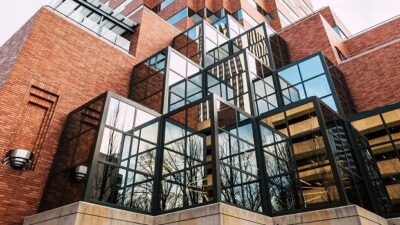Mentoring the next generation of engineers and architects is crucial to the future of the built environment.

Mentoring the next generation of engineers and architects is crucial to the future of the built environment. To help in the transition from student to practicing engineer, some educational institutions have partnered with private firms to train students to apply what they have learned to real project scenarios. I have had the privilege of working with seniors at Stony Brook University in New York to help prepare them for their capstone projects before graduating. Working with about six or seven students, a group of Dewberry engineers set up a real-life structural engineering project scenario for the students to complete. Once they had worked through the project with volunteers from our firm, they presented the final project to their professor before graduation.
Teaching the Fundamentals
A structural system can be determined based on cost implications. In one project scenario, the owner, played in this case by Dewberry, had not expressed the desire to use a particular system, rather focusing on a desired cost. The students began their analysis by determining the available construction methods. The list was reduced to five methods for the students to analyze. They then conducted a typical bay analysis with the various construction methods. After the design phase, the students created a cost estimate of the different construction methods and prepared a short presentation. Our firm’s volunteers assisted through each phase of the analysis.
Through these projects, we hope to hone in on the students’ understanding of technical topics and their application to different scenarios, such as structural analysis, development of design criteria, cost estimating, and project planning.
There are two fundamental concepts that we hope these students walk away with:
- As an engineer, people are putting trust in you for their safety and quality of life
- Due diligence is key, make note of anything that doesn’t seem right
Navigating Program Challenges
One of the biggest obstacles that we needed to overcome was creating an effective curriculum for all students, despite each having a wide variety of interests and different level of understanding of certain technical topics. While our mentorship focused on building structures projects, the students aspired to work in other fields like environmental and transportation engineering. This required us to adapt the curriculum to best fit the learning pace and interests of each student. Our group had regular one-on-one sessions to work with each student.
Reward Meets Reward
Throughout their curriculum, students are bombarded with technical information. By working through the project scenario, they learn that only pieces of the technical information will apply to the task at hand. The program teaches each student to consider the importance of their work. Additionally, working through a real-life scenario moves them beyond the mindset of solving “just another homework problem.” Based on feedback we received from the program, this real-life project experience has helped them to hit the ground running when they start a job at a firm after graduation.
Like the students, I too have learned a lot through the program. It has offered me the opportunity to place myself back in their shoes and see project challenges through their eyes, which helps me in working with junior staff on my projects at Dewberry. Additionally, the program has advanced my communication skills. Whether it be in drawing a quick diagram or sending students to an external resource, I am now able to better direct younger engineers in their project work and explain concepts and solutions to my teammates and clients with a clearer voice. Our organization also benefits from the relationships we build through the program. One student recently joined our firm, and we continue to keep an open dialogue with other students and faculty at Stony Brook University.
Giving Back to the Profession
In addition to firm-sponsored programs, students can also get help through education committees that center on teaching students how to apply what they’ve learned in school. Engineers who might not have time to commit themselves to an entire program like the one at Stony Brook University can still give back by volunteering in advisory roles for education committees. Another way one can get involved is by giving a Q&A seminar at a local school. This can be done at any level of learning and many educational institutions would welcome a volunteer with open arms.
This article originally appeared on Dewberry’s website. Dewberry is a CFE Media content partner.



